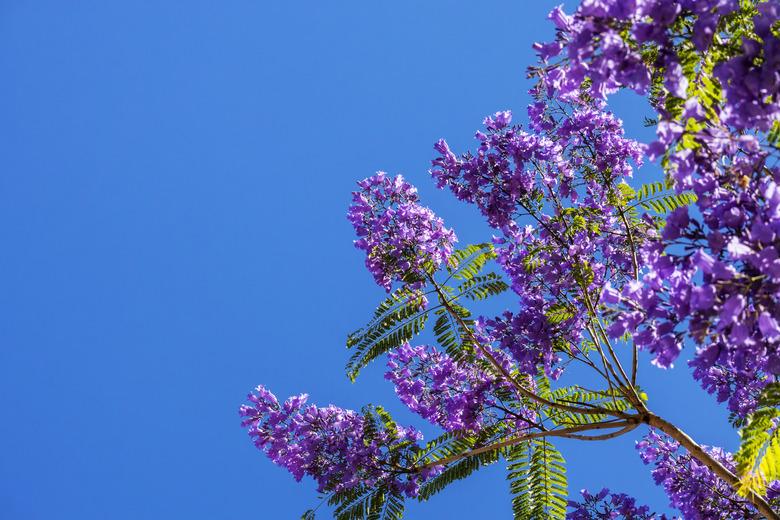Jacaranda Leaves Vs. Poinciana Leaves — What Are The Differences?
Jacaranda (Jacaranda mimosifolia) and royal poinciana (Delonix regia) trees both have delicate, fern-like foliage. Both are large trees with vase-like to spreading canopies that create light dappled shade. Both also grow well in urban areas and can be used in parking lots and along streets without sidewalks in U.S. Department of Agriculture plant hardiness zones 9b through 11 and 10 through 12, respectively. Since both trees drop large amounts of flower and seed litter, they are not good near patios, decks or walkways.
About Jacaranda Leaves
Each jacaranda leaf measures 8 to 15 inches long and is bi-pinnate, which means it is composed of major and minor leaflets. It has 13 to 25 pairs of major leaflets arranged alternately along the midrib. The up to 18-inch-long major leaflets consist of 13 to 25 smaller or minor leaflets. The leaflets are less than 2 inches long and vary from rhomboid, or diamond-shaped, to obovate with the broadest part of the leaflet just above its middle. The leaves are green with lighter green undersides and turn brown in the fall before dropping from the tree.
About Royal Poinciana Leaves
A royal poinciana leaf is also bi-pinnate, with 10 to 20 pairs of major leaflets alternately growing along the mid-rib. Each 8- to 15-inch-long major leaflet is finely divided into 25 to 35 pairs of minor leaflets, which gives it a finer texture than the jacaranda leaves. Each oblong leaflet is less than 2 inches long. The leaf has a green upper surface and a paler green lower surface. Royal poinciana trees, also called flamboyant trees, are deciduous with brown foliage in the fall in the cooler winter climates and evergreen in the tropics.
Differences in the Flowers
Both trees have showy flowers that cover the tree when they bloom. The jacaranda tree has 1-inch, trumpet-shaped, lavender-blue flowers that grow in dense 6- to 10-inch-long clusters. The lightly fragrant flowers bloom in the spring, sometimes before the leaves appear, and into the summer. When the petals fall from the tree, they form "pools" of blue under the tree.
The royal poinciana has large clusters of brilliant red-orange or yellow flowers in early summer and midsummer. Each 3- to 4-inch flower has four petals up to 2 inches long and a larger fifth "banner" petal streaked with yellow and white.
Other Differences Between the Trees
Jacaranda, a member of the Bignoniaceae family, is a fast-growing tree from Argentina and Bolivia that reaches 25 to 40 feet tall and equally wide at maturity. The arching trunk has thin, grayish-brown bark that becomes scaly with age. It has light reddish-brown twigs that zigzag slightly, and thorns. Flat, round, woody, reddish-brown capsules contain numerous small, winged seeds. Grafted jacaranda may bloom as quickly at two to three years old, but when grown from seed, the tree needs seven to 14 years to mature and produce flowers.
Royal poinciana is native to Madagascar. A member of the pea or Fabaceae family, it is also fast growing to 35 to 40 feet tall and 40 to 60 feet wide with a symmetrical flat-crowned canopy. It has many branches with smooth, gray bark, reddish-brown twigs and thorns. The woody seedpod grows 2 inches wide and 14 to 20 inches long and turns reddish-brown to nearly black when ripe. Trees grown from seed require seven to 10 years of growth before flowering.
